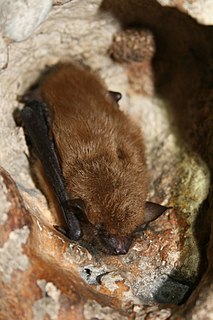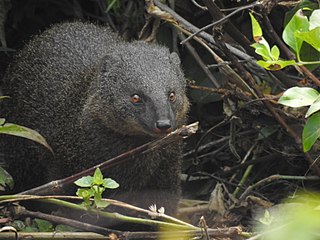Related Research Articles

The lesser black-backed gull is a large gull that breeds on the Atlantic coasts of Europe. It is migratory, wintering from the British Isles south to West Africa. It is a regular winter visitor to the east coast of North America, probably from the breeding population in Iceland.

The jungle myna is a myna, a member of the starling family. It is found patchily distributed across much of the mainland of the Indian Subcontinent but absent in the arid zones of India. It is easily recognized by the tuft of feathers on its forehead that form a frontal crest, a feature also found in the closely related Javan myna and the pale-bellied myna which were treated as a subspecies in the past. The eyes are pale, yellow or blue depending on the population and the base of the orange-yellow bill is dark. It has also been introduced either intentionally or accidentally into many other parts of the world including Fiji, Taiwan, the Andaman Islands, and parts of Japan. The species has also spread out on its own to some islands in the Pacific.

The big brown bat is a species of vesper bat distributed widely throughout North America, the Caribbean, and the northern portion of South America. It was first described as a species in 1796. Compared to other microbats, the big brown bat is relatively large, weighing 15–26 g (0.53–0.92 oz) and possessing a wingspan of 32.5–35 cm (12.8–13.8 in). Big brown bats are insectivorous, consuming a diverse array of insects, particularly night-flying insects, but especially beetles. Some of the beetles it consumes are serious agricultural pests, including cucumber beetles. They are nocturnal, foraging for prey at night and roosting in sheltered areas during the day such as caves, tunnels, tree cavities, and human structures. Their breeding season is in the fall, shortly before their annual hibernation. After hibernation ends in the spring, females form maternity colonies for giving birth to young. Oftentimes only one offspring is produced per litter, though twins are common in the Eastern US. Lifespans of 6.5 years are considered average.

Pelobates fuscus is a species of toad in the family Pelobatidae, native to an area extending from Central Europe to Western Asia. It is commonly known as the common spadefoot, garlic toad, the common spadefoot toad and the European common spadefoot.
Domitian's Dacian War was a conflict between the Roman Empire and the Dacian Kingdom, which had invaded the province of Moesia. The war occurred during the reign of the Roman emperor Domitian, in the years 86–88 CE.

The Indian brown mongoose is a mongoose species native to the Western Ghats in India and the western coast in Sri Lanka. It is listed as Least Concern on the IUCN Red List.
The Guadeloupe big brown bat is a species of vesper bat. It is found only on the island of Guadeloupe. It is one of the 11 species of bat found on Guadeloupe, and one of the 3 that are endemic.
The plateau vole is a species of rodent in the family Cricetidae. It is found only in China. Its natural habitat is temperate grassland.
The mottled-tailed shrew mouse is a species of rodent in the family Muridae. It is found in West Papua, Indonesia and Papua New Guinea.

The broad-toothed rat is a species of rodent in the family Muridae.
Cornelius Fuscus was a Roman general who fought campaigns under the Emperors of the Flavian dynasty. During the reign of Domitian, he served as prefect of the imperial bodyguard, known as the Praetorian Guard, from 81 until his death in 86 AD. Prior to this appointment, Fuscus had distinguished himself as one of Vespasian's most ardent supporters during the civil war of 69 AD, known as the Year of the Four Emperors.
Nephroisospora is a genus of parasites that infects bats

The Tomb of Hilarus Fuscus(Latin: Hilarus Fuscus or Hilarius Fuscus) is a funerary monument, located near the fourth mile of the Appian Way or Via Appia Antica, to the southeast of Rome. The tomb was restored by Luigi Canina in the mid-1800s. An inscription bearing the names of those represented on the masonry disappeared in the period between 1978 and 1998. The sculptures are copies: the originals are now in the National Museum of the Baths of Diocletian.
Ptericoptus is a genus of beetles in the family Cerambycidae, containing the following species:
Ptericoptus intermedius is a species of beetle in the family Cerambycidae. It was described by Breuning in 1939. It is known from Mexico.
Ptericoptus meridionalis is a species of beetle in the family Cerambycidae. It was described by Breuning in 1939. It is known from Paraguay and Argentina.
Ptericoptus acuminatus is a species of beetle in the family Cerambycidae. It was described by Johan Christian Fabricius in 1801. It is known from Argentina, Brazil and Paraguay.
Ptericoptus caudalis is a species of beetle in the family Cerambycidae. It was described by Henry Walter Bates in 1880. It is known from Guatemala, Honduras, and Mexico.
Ptericoptus clavicornis is a species of beetle in the family Cerambycidae. It was described by Johan Christian Fabricius in 1801. It is known from Guyana and French Guiana.
Ptericoptus dorsalis is a species of beetle in the family Cerambycidae. It was described by Audinet-Serville in 1835. It is known from Brazil.
References
- ↑ BioLib.cz - Ptericoptus fuscus. Retrieved on 8 September 2014.
| This Apomecynini article is a stub. You can help Wikipedia by expanding it. |